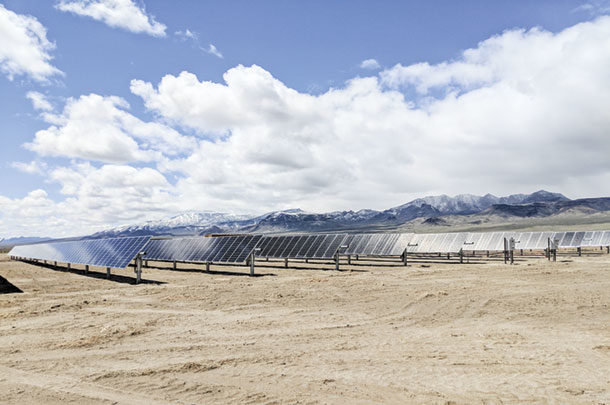But producers are making alfalfa hay operations work even in pivot-irrigated stands.
Railroad Valley Farms is situated at roughly 4,900 feet elevation and is only about two hours from Death Valley National Park – does that tell you how dry it is? (They didn’t name it “Death Valley” for nothing.) The Tonopah area receives annually about 5 to 6 inches of precipitation, but groundwater is still accessible.
When the early silver mining claims played out, there was little to economically sustain the area until pivot irrigation became available. And in more recent years, with its proximity to California and California’s regulatory practices and transition of hay acres to high-end vegetables and nuts, central Nevada’s alfalfa growers have found an eager and accessible hay market in California’s dairies.
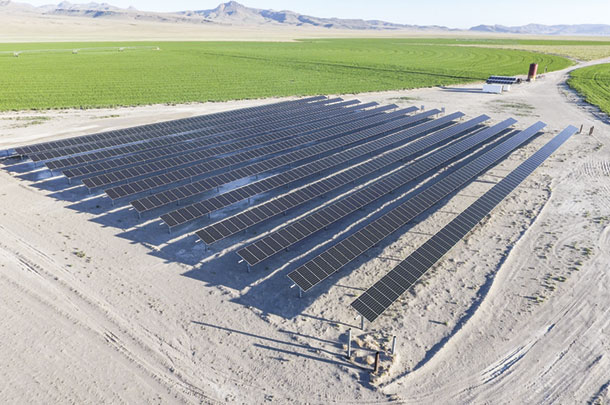
The trouble was: The 1,000 acres of alfalfa at Railroad Valley Farms were still off the grid. Using direct-drive diesel engines to pump the water (and power the pivots), producers there had been able to overcome the power obstacle to some extent, but diesel costs varied from year to year. “In a really good year, our energy costs – factoring fuel and maintenance and everything – probably cost in the 300 dollars per acre range, but we’ve had it as bad as 500 dollars per acre [per year], which is our biggest cost,” says co-owner Mark Dunn.
His red fuel cost in October 2019 was $2.15 per gallon, but climbed steadily and has been at $2.30 to $2.40 per gallon since then. “On a year like this,” he says of 2019, “fuel would have been about 25 percent of the total cost per acre. It’s been as high as 50 percent. It’s our biggest input.”
Dunn says the economics of diesel fuel was what drove him to look into solar power on a large operational scale – something no one he knows has tried successfully. “With high fuel cost and high hay prices, we’re fine – it doesn’t matter. Low fuel costs and low hay prices – we’re still OK. Low fuel cost and high hay prices – well, that’s terrific, but how often does that happen? But high fuel costs and low hay prices? That kills us, and we won’t survive that,” Dunn says.
Identifying opportunities
His only option to diesel seemed to be solar power. “The problem for me, looking at solar,” Dunn says, “had always been that we have to run 24 hours a day, and the sun isn’t shining 24 hours a day. So how could we meet the crop demand and actually still be able to pay for the solar? We knew right off the bat there was no technology that would be cheap enough to do 100 percent solar.” So he looked for hybrid energy functionality to power his pivots, part of which included solar.
Right away, Dunn recognized maximizing a solar system would require a system that could pick up the sun as soon as it rose and track its motion across the sky. With multiple rows of solar panels that track the sun, there is a potential for each row to shade the row behind it. So they don’t roll over immediately when the sun rises but roll over slowly, so as to not shade the panels behind them. His system called for an array of panels in 12 rows of 80 panels each, spaced about 20 feet apart for a total footprint of about 1.5 acres.
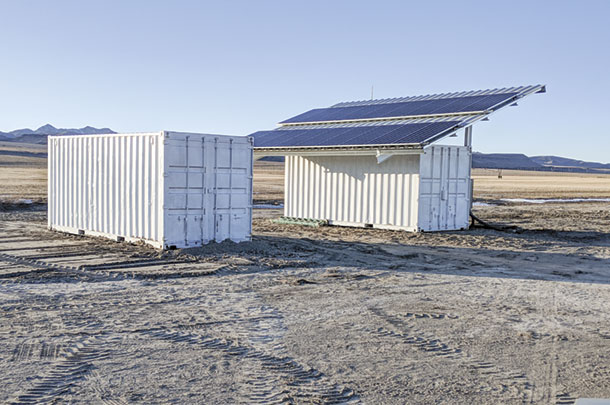
Since a solar-powered system hadn’t been used before in this application, Dunn relied on solar modeling to figure out how much power could be produced and how many hours of pumping time he could get. “I also had to think about irrigating. With solar, you’ve essentially bought 25 years of power right up-front and you have to make it pay for itself. So you want to take advantage of any power at any time that system is capable of,” he says. “We knew we’d have to irrigate every day of the year that the sun is shining and it’s not freezing, trying to bank water in the soil and take advantage of any power production.”
After the modeling, Dunn tried to get a handle on the budget for the project and contacted a company that built solar systems, asking for a bid. Dunn says, “Literally, the guy who gave us our estimate said, ‘We’ll build a 50-kilowatt system.’ And we said, ‘No, we’re thinking more like a 200-kilowatt system.’ So he said, ‘OK, that will cost about four times as much as a 50-kilowatt system.’ Well, it turned out to be way more complicated than that, and it was more of an exponential multiplier than linear multiplier. That was the biggest problem.”
The rest of the viability equation rested upon how much fuel could be saved. “My price point for my financial model was that diesel would have to cost about a dollar-eighty before the solar model was not cost-effective,” Dunn says. “So any time diesel is over a dollar-eighty per gallon, I’ll save money.”
The first season
Dunn had the first system built to power four quarter-mile pivots with variable-speed drives, covering 500 acres of alfalfa. He’s using two 325-kilowatt (DC) arrays to power 175-kilowatt (AC) systems, so he currently has a lot of extra capacity. That’s because the output of solar really changes depending on temperature – the hotter it gets, the less it puts out. (On a cold winter day, the output is at a higher capacity than on a hot summer day, when it might be only running at 50% of its rated capacity.) “We’re running purely on solar from about October until the middle of May,” he says, “depending on what’s happening with the weather. Then in the summer, the backup to the solar system is a diesel-powered generator system.”
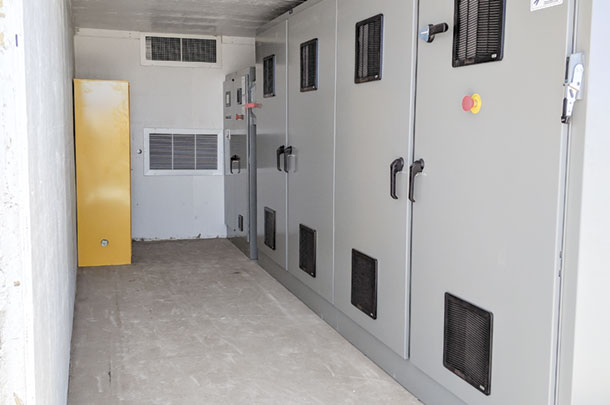
The diesel-powered generator is still vital to the system. Dunn says, “You have to take into account that it’s not only nighttime when solar isn’t running, but also any time a cloud rolls over and blocks the sun, it really reduces the amount of power the panels can put out. In order to keep the system running, our system is designed to automatically power up the diesel to supplement solar at any time and at the same time. It’s the amount of diesel the solar offsets that makes it work. We offset 60 percent of our diesel fuel needs in the first year – and we didn’t get it up and running until late April [of 2019], so we didn’t get the advantage of winter pre-irrigation. But even with that, we saved 60 percent of our fuel costs. The model suggests we can save 70 percent, and I think we can get closer to 75 percent ideally.”
Will it work for everyone?
When approaching a banker for project investment, purchasing 25 years’ worth of energy up-front might be a hard sell for any producer. The good news is: Dunn now knows a lot more about true costs to build the system and can validate the generating model to determine how much power can be produced. Still, he cautions, it’s not a system that will work for everyone.
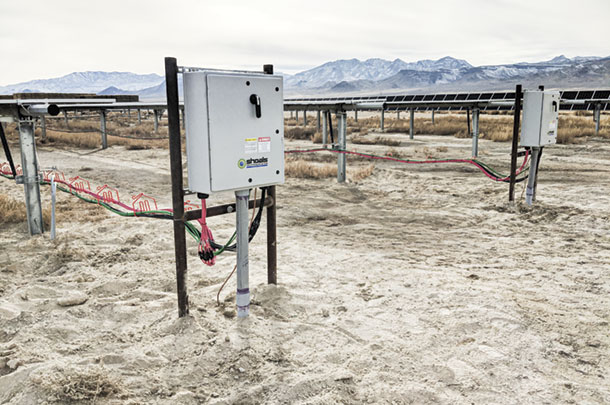
“I’ve talked to farmers who are freaking out because they’re spending close to 200 dollars per acre on energy. I would have been thrilled to only spend 200 dollars, but every operation is different. It’s going to have the most impact for farms in an area where you could produce a crop year-round, and that’s probably a better fit than if you’re in a high mountain valley and only get one or two hay cuttings a year and can’t get any power from the system for four to six months a year. It’s really more for a remote, off-grid type of system,” Dunn says.
What makes a solar system economically viable? Dunn says, “The most efficient way to use a solar system, that I see, is to have a system that you’re able to use 100 percent of the power you generate and only have to supplement with a purchased source, with enough cost savings on the power purchase to justify the expenditure. If you have high demand charges, or high use during a high demand time, it might offset the expense, but for guys like me who were using all diesel, this is a great answer.” ![]()
PHOTO 1: The System B array is shown tracking the early morning sun.
PHOTO 2: This aerial view of System B shows a PV array, generator, control room and the fields the system irrigates.
PHOTO 3: Shown is the generator and control room enclosures for System B. The control room is powered by its own 6kW PV array with 10kWh battery backup.
PHOTO 4: This is inside the control room – shown are the motor control center enclosure and console panel enclosure (gray cabinets), and the battery enclosure (yellow cabinet housing 10kWh LiFeP batteries).
PHOTO 5: PV combiners and DC wiring are shown shortly after installation. Photos by Mark Dunn.
Mark Dunn is happy to answer questions for anyone considering this option. Email Mark Dunn or by phone at (775) 412-8678.
